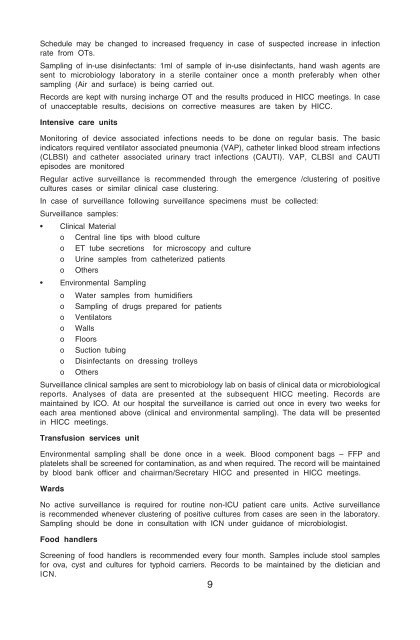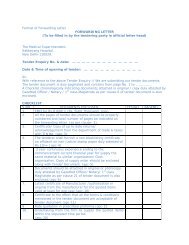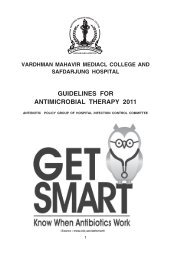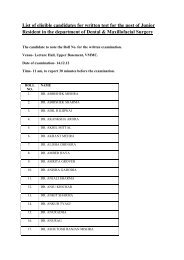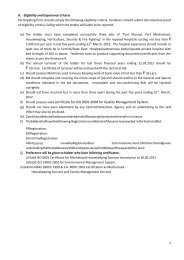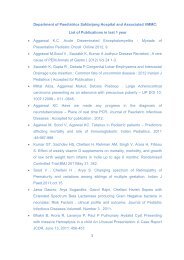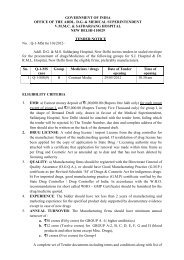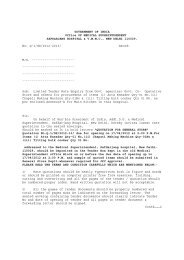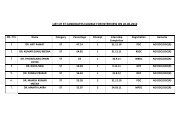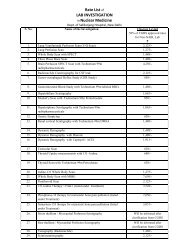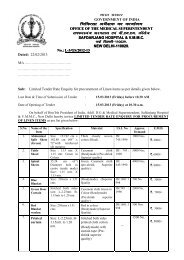Guidelines for INFECTION CONTROL POLICY - Safdarjung Hospital
Guidelines for INFECTION CONTROL POLICY - Safdarjung Hospital
Guidelines for INFECTION CONTROL POLICY - Safdarjung Hospital
You also want an ePaper? Increase the reach of your titles
YUMPU automatically turns print PDFs into web optimized ePapers that Google loves.
Schedule may be changed to increased frequency in case of suspected increase in infectionrate from OTs.Sampling of in-use disinfectants: 1ml of sample of in-use disinfectants, hand wash agents aresent to microbiology laboratory in a sterile container once a month preferably when othersampling (Air and surface) is being carried out.Records are kept with nursing incharge OT and the results produced in HICC meetings. In caseof unacceptable results, decisions on corrective measures are taken by HICC.Intensive care unitsMonitoring of device associated infections needs to be done on regular basis. The basicindicators required ventilator associated pneumonia (VAP), catheter linked blood stream infections(CLBSI) and catheter associated urinary tract infections (CAUTI). VAP, CLBSI and CAUTIepisodes are monitoredRegular active surveillance is recommended through the emergence /clustering of positivecultures cases or similar clinical case clustering.In case of surveillance following surveillance specimens must be collected:Surveillance samples:• Clinical Materialo Central line tips with blood cultureo ET tube secretions <strong>for</strong> microscopy and cultureo Urine samples from catheterized patientso Others• Environmental Samplingo Water samples from humidifierso Sampling of drugs prepared <strong>for</strong> patientso Ventilatorso Wallso Floorso Suction tubingo Disinfectants on dressing trolleyso OthersSurveillance clinical samples are sent to microbiology lab on basis of clinical data or microbiologicalreports. Analyses of data are presented at the subsequent HICC meeting. Records aremaintained by ICO. At our hospital the surveillance is carried out once in every two weeks <strong>for</strong>each area mentioned above (clinical and environmental sampling). The data will be presentedin HICC meetings.Transfusion services unitEnvironmental sampling shall be done once in a week. Blood component bags – FFP andplatelets shall be screened <strong>for</strong> contamination, as and when required. The record will be maintainedby blood bank officer and chairman/Secretary HICC and presented in HICC meetings.WardsNo active surveillance is required <strong>for</strong> routine non-ICU patient care units. Active surveillanceis recommended whenever clustering of positive cultures from cases are seen in the laboratory.Sampling should be done in consultation with ICN under guidance of microbiologist.Food handlersScreening of food handlers is recommended every four month. Samples include stool samples<strong>for</strong> ova, cyst and cultures <strong>for</strong> typhoid carriers. Records to be maintained by the dietician andICN.9


